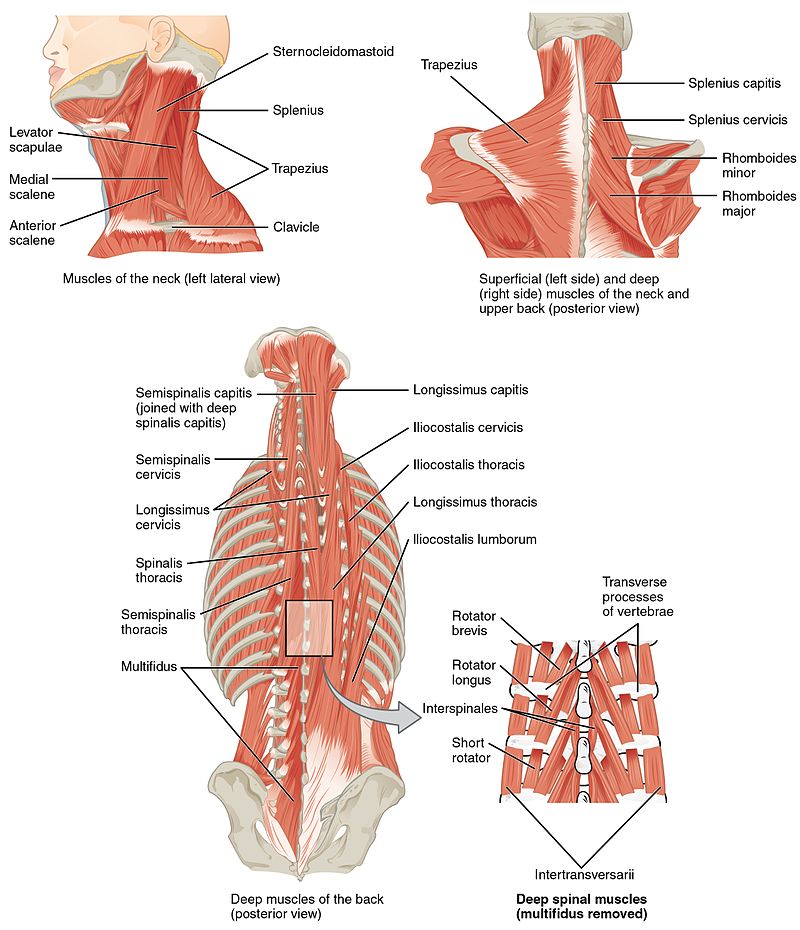[1]
Wang D, Ding Y, Wu B, Si F, Yu F, Xiao B, Liu B. Cervical Extensor Muscles Play the Role on Malalignment of Cervical Spine: A Case Control Study With Surface Electromyography Assessment. Spine. 2021 Jan 15:46(2):E73-E79. doi: 10.1097/BRS.0000000000003742. Epub
[PubMed PMID: 33038198]
Level 2 (mid-level) evidence
[2]
Creze M, Soubeyrand M, Gagey O. The paraspinal muscle-tendon system: Its paradoxical anatomy. PloS one. 2019:14(4):e0214812. doi: 10.1371/journal.pone.0214812. Epub 2019 Apr 8
[PubMed PMID: 30958835]
[3]
Sato T, Koizumi M, Kim JH, Kim JH, Wang BJ, Murakami G, Cho BH. Fetal development of deep back muscles in the human thoracic region with a focus on transversospinalis muscles and the medial branch of the spinal nerve posterior ramus. Journal of anatomy. 2011 Dec:219(6):756-65. doi: 10.1111/j.1469-7580.2011.01430.x. Epub 2011 Sep 29
[PubMed PMID: 21954879]
[6]
Kwon HJ, Yang HM, Won SY. Intramuscular innervation patterns of the splenius capitis and splenius cervicis and their clinical implications for botulinum toxin injections. Clinical anatomy (New York, N.Y.). 2020 Nov:33(8):1138-1143. doi: 10.1002/ca.23553. Epub 2020 Jan 12
[PubMed PMID: 31894602]
[7]
Mukherjee I. Invited commentary on "Effects of erector spinae plane block on postoperative pain and side-effects in adult patients underwent surgery: A systematic review and meta-analysis of randomized controlled trials". International journal of surgery (London, England). 2020 Aug:80():35. doi: 10.1016/j.ijsu.2020.06.028. Epub 2020 Jun 22
[PubMed PMID: 32585193]
Level 3 (low-level) evidence
[9]
Zoabli G, Mathieu PA, Aubin CE. Magnetic resonance imaging of the erector spinae muscles in Duchenne muscular dystrophy: implication for scoliotic deformities. Scoliosis. 2008 Dec 29:3():21. doi: 10.1186/1748-7161-3-21. Epub 2008 Dec 29
[PubMed PMID: 19114022]
[10]
Tian Y, Bai B, Cui LX, Liang XN, Li QS, Huang GY. [Iliocostalis Plane Block in Analgesia for Video-assisted Thoractomy:Report of One Case]. Zhongguo yi xue ke xue yuan xue bao. Acta Academiae Medicinae Sinicae. 2019 Dec 30:41(6):871-874. doi: 10.3881/j.issn.1000-503X.11942. Epub
[PubMed PMID: 31907142]
Level 3 (low-level) evidence
[11]
Gonzales JR, Iwanaga J, Oskouian RJ, Tubbs RS. Variant Prevertebral Muscle: Unique Cadaveric Findings. Cureus. 2017 Jul 25:9(7):e1515. doi: 10.7759/cureus.1515. Epub 2017 Jul 25
[PubMed PMID: 28959510]
[12]
Hu ZJ, Fang XQ, Fan SW. Iatrogenic injury to the erector spinae during posterior lumbar spine surgery: underlying anatomical considerations, preventable root causes, and surgical tips and tricks. European journal of orthopaedic surgery & traumatology : orthopedie traumatologie. 2014 Feb:24(2):127-35. doi: 10.1007/s00590-012-1167-9. Epub 2013 Feb 17
[PubMed PMID: 23417108]
[13]
Hofste A, Soer R, Hermens HJ, Wagner H, Oosterveld FGJ, Wolff AP, Groen GJ. Inconsistent descriptions of lumbar multifidus morphology: A scoping review. BMC musculoskeletal disorders. 2020 May 19:21(1):312. doi: 10.1186/s12891-020-03257-7. Epub 2020 May 19
[PubMed PMID: 32429944]
Level 2 (mid-level) evidence
[14]
Atlas SJ, Deyo RA. Evaluating and managing acute low back pain in the primary care setting. Journal of general internal medicine. 2001 Feb:16(2):120-31
[PubMed PMID: 11251764]
[15]
Viswanath O, Rasekhi R, Suthar R, Jones MR, Peck J, Kaye AD. Novel Interventional Nonopioid Therapies in Headache Management. Current pain and headache reports. 2018 Mar 19:22(4):29. doi: 10.1007/s11916-018-0681-9. Epub 2018 Mar 19
[PubMed PMID: 29556851]
[16]
Iwamuro H, Takahashi H, Ide K, Nakauchi J, Taniguchi M. [Peri-operative treatment with botulinum A toxin prior to posterior cervical decompression in a case with cervical spondylosis caused by spasmodic torticollis secondary to cerebral palsy]. No shinkei geka. Neurological surgery. 2003 Sep:31(9):1015-20
[PubMed PMID: 14513786]
Level 3 (low-level) evidence

